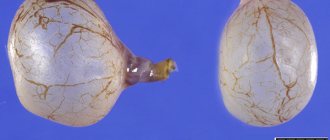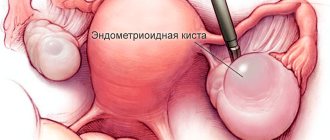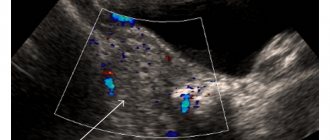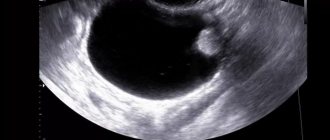Causes of ovarian corpus luteum cyst
The corpus luteum is a temporary hormonal structure that appears from the cells of a ruptured follicle. It is responsible for the production of progesterone, a hormone necessary to support the development of pregnancy. If in the current menstrual cycle the egg is not fertilized, then the hormonal formation should decrease and degenerate into a white body.
Sometimes the regression process does not begin, and as a result, a luteal cyst is formed in the ovary. The causes of disturbances in the development of the temporary hormonal gland have not yet been sufficiently studied. In phase 2 of the cycle, cystic structures are formed due to hormonal imbalance and disruption of the circulatory process.
The main factors under the influence of which the development of cystic formations occur:
- using medications to stimulate ovulation;
- taking medications in IVF protocols;
- use of emergency contraception;
- prolonged stress;
- regular exhausting physical activity;
- starvation, underweight;
- frequent artificial terminations of pregnancy;
- chronic and acute inflammation of the appendages;
- pathologies of endocrine organs.
A luteal cystic structure may appear in phase 2 of the cycle or after pregnancy. At the same time, fluid accumulates in the cavity in which the corpus luteum is located, its walls stretch.
Complications and consequences
Usually the formations do not pose a danger and disappear on their own after a while. If the course of the disease becomes more complicated, the following occurs:
- Torsion of the cyst stalk can be complete or partial. As a result, due to pressure on nerve fibers and blood vessels, the nutrition of the ovaries is disrupted. The patient complains of severe pain that radiates to the groin. There is also a feeling of anxiety, dizziness, nausea, and blood pressure decreases. When torsion occurs, the basal temperature rises, and the pain does not go away, even if you lie down or sit comfortably,
- Cyst rupture - when the formation bursts, there is piercing pain in the ovaries, cold sweat, lightheadedness and dizziness. In such cases, hospitalization is mandatory,
- Cycle disruptions - hormonal imbalance provokes a delay of 1-2 weeks. After this time, menstruation comes, but it is painful and with clots. This type of menstruation is often called uterine bleeding.
- Internal bleeding - when the gland bursts, a hematoma occurs, which increases and bursts the organ. As a result, the ovary ruptures, and blood enters the peritoneum and pelvic area. The patient is in a state of shock, severe weakness is observed, blood pressure decreases and the pulse quickens.
The occurrence of such complications occurs due to the rapid growth of the tumor, sudden body movement, and intense sexual intercourse.
Symptoms of ovarian corpus luteum cyst
A yellow ovarian cyst can form only in phase 2 of the cycle after the oocyte is released from the follicle. Temporary neoplasms are small in size, their diameter is usually 40-80 mm.
Reference! Such benign tumors are rarely diagnosed. This is due to the fact that in many women their appearance is asymptomatic.
But in some women, when luteal tumors form, the following signs appear:
- pain in the lower abdomen, discomfort concentrated on the right or left depending on the location of the cystic formation;
- a feeling of discomfort in the abdomen, a feeling of heaviness or fullness;
- delayed menstruation;
- prolongation of the duration of menstruation, it is caused by uneven rejection of the endometrium.
With hormonal dysfunction, progesterone may accumulate in excess quantities. In this case, menstruation is delayed, and the woman may experience characteristic signs of pregnancy, although the egg has not been fertilized.
Diagnosis of ovarian corpus luteum cyst
Ultrasound diagnostics can reveal a cystic neoplasm in the ovary. A gynecologist may suspect the appearance of a corpus luteum cyst in the left ovary during a manual examination. Pathology will be indicated by its increase, pain during examination, or the detection of a cystic formation in its projection.
But gynecological examination data is not enough to make a diagnosis. Indeed, upon palpation, it is difficult to distinguish a cystic neoplasm from an ectopic pregnancy, an ovarian tumor, or an increase in its size due to oophoritis. Therefore, patients are prescribed an ultrasound examination.
When performing an ultrasound, the cyst is easy to detect. It is visualized as a rounded anechoic formation with a homogeneous structure. It has a clearly defined capsule. Cysts differ in their internal structure. Ultrasound may reveal:
- anechoic homogeneous formation;
- anechoic structure of irregular shape with partitions inside;
- homogeneous anechoic formations with smooth or mesh wall structures;
- tumors, inside of which there is a parietal mid-echoic area, this is how blood clots inside the cyst are visualized.
Most often, doctors detect a cystic corpus luteum in the right ovary. The process of tumor formation in the right and left ovaries does not differ, but the likelihood of their formation on the right is higher due to the increased number of vessels on this side.
If it is difficult to establish a diagnosis based on the results of an ultrasound, then color Doppler sonography may be prescribed. This examination allows you to distinguish a tumor from a cyst. Blood flow is preserved in ovarian tumors, but it is absent in luteal cystic neoplasms.
The doctor may also recommend donating blood for the CA-125 tumor marker. In benign formations it should be absent. If a luteal cyst is detected against the background of delayed menstruation, you need to donate blood for hCG or do a pregnancy test. In such a situation, it is possible that fertilization of the egg has occurred.
Are luteal cysts dangerous? luteal cyst of the left ovary
Corpus luteum
To understand what a luteal cyst of the right ovary (as well as the left) is and how it differs from other formations in this organ, it is worth considering in detail the process of its formation.
As soon as the egg reaches maturity, the level of estrogen in the woman’s body reaches its maximum value, after which the pituitary gland begins to secrete luteinizing hormone to stimulate ovulation.
Next, the follicle ruptures, after which the egg enters the fallopian tube.
Increase
The next phase is luteinization. In other words, the follicle is transformed after ovulation directly into the corpus luteum. The granular layer of the follicle multiplies and turns yellow due to the presence of lipochrome pigment.
In a normal state, when pregnancy does not occur, it begins to atrophy, the amount of hormones drops below, to the level that is necessary for the normal functioning of the endometrium of the uterus, after which menstruation occurs. The situation is different with pregnancy. Due to the fact that implantation of the embryo into the uterus requires the presence of a certain level of progesterone in the body, the corpus luteum for a certain time is a kind of hormonal organ that produces it. The corpus luteum exists for the first 4 months of pregnancy, after which its reverse development occurs.
If this does not happen, for certain reasons, a luteal cyst forms. It is not considered a disease due to the fact that it has no symptoms. This is the reason why pathology is classified as a physiological condition. Therefore, such a cyst of the left ovary (as well as the right one) differs from other pathologies of the organ in that it resolves itself over time.
Diagnostic methods
Diagnosis of pathology does not cause difficulties:
- During a gynecological examination in a chair, the doctor can feel the cyst.
- For a reliable diagnosis, ultrasound is prescribed. A cavity of up to 8 centimeters with fluid inside is visualized on the ovary.
- Doppler examination. It is used to evaluate blood flow. In luteal cysts there is no blood flow, while in tumor formations it is detected.
- Blood test for hCG to exclude pregnancy and tumor markers to exclude oncology.
If a cyst is detected, the doctor prescribes observation of it for three months . Usually the formation disappears on its own.
Causes of luteal cysts
The formation of a neoplasm can be caused by the following reasons:
- hormonal imbalance that occurred due to any pathology of the endocrine glands (for example, hypothyroidism). This also includes incorrectly administered hormone therapy for the underlying disease, improper use of oral contraceptives, and use of drugs that are involved in stimulating the ovulatory cycle;
- persistent stressful situations;
- physical and/or mental fatigue;
- hypothermia at the time of ovulation;
- occupational hazards and diseases;
- drug abuse;
- sexually transmitted infections;
- bad habits;
- Weight loss, which interferes with estrogen production;
- inflammatory diseases of the pelvic organs;
- abortion, which can also cause hormonal imbalance;
- oncological diseases.
Source: https://stopzaraza.com/gormony/lyuteinovaya-kista-yaichnika-chem-opasna-i-kak-vliyaet-na-zhenskoe-zdorove.html
Corpus luteum cyst of the ovary: what to do
If a cyst of the corpus luteum of the left ovary is detected, treatment is not prescribed. If there are no symptoms or they are mild, then the patient is simply observed for several months. Ultrasounds are performed monthly to evaluate changes in the size of the cystic gland and its contents. In the vast majority of cases, they resolve within 2-3 months.
If the patient is diagnosed with constant relapses or the cystic structures do not regress on their own, the doctor may prescribe conservative treatment. In rare cases, surgery is required. Emergency surgery is needed if complications arise: rupture of the cyst, twisting of the pedicle, or necrosis of the tissue of the gonad.
Causes
A functional corpus luteum cyst can resolve on its own over several menstrual cycles. This condition does not require medical intervention. If growth increases and the size begins to exceed the permissible 8 cm, treatment will be required.
The process by which the disease occurs is not fully understood. The main factor is the imbalance of a woman’s hormonal levels, but other reasons can also provoke the development of pathology.
Why does a corpus luteum cyst form?
- uncontrolled use of hormonal drugs;
- a history of ectopic pregnancy;
- regular abortions;
- imbalance of hormones in the body;
- chronic diseases of the pelvic organs;
- heavy physical and mental stress, severe stress;
- underweight or overweight.
The corpus luteum, which is cystically altered, may also be a consequence of a genetic predisposition or individual characteristics of the body. It occurs regardless of the age category, but the presence of previous problems with the reproductive organs in a woman can aggravate the medical history.
Corpus luteum cyst of the ovary: size, norm and deviation
Normally, women in the second phase should form a temporary luteal gland, which regresses by the beginning of menstruation. The appearance of a cyst in its place is a deviation. But you shouldn’t be scared; this tumor-like formation goes away on its own in most women.
In phase 2 of the cycle, the diameter of the standard corpus luteum should be 18-27 mm. If an anechoic structure with a diameter of more than 30-35 mm is detected on ultrasound, it is diagnosed that a cyst has formed in place of the corpus luteum. Its main difference is that it is anechoic; it does not transmit ultrasonic waves and appears on the screen as a dark spot.
Reference! The standard size for a luteal cystic structure is 4-8 cm. Deviations are rare, because the capsule in which it is located cannot stretch further.
In some patients, ultrasound is diagnosed with an ovarian corpus luteum cyst with hemorrhage. When it appears, it is important to monitor the patient’s condition. If bleeding from the vessels into the cystic capsule continues, it may rupture. But sometimes such tumors regress on their own.
Dynamics of education growth and possible dangerous consequences
The development of corpus luteum pathology can follow different scenarios:
- The formation decreases in size and disappears without a trace within 1-3 months,
- The cyst continues to grow slowly, without causing much discomfort, but also without regressing,
- The formation steadily increases in size and continues to grow after 3 or more months.
In the latter case, the risk of complications increases:
- Torsion of the pedicle of the formation. Occurs during physical activity, intimacy, sudden movements, jumping, dancing, turning. Leads to severe pain in the lower abdomen on the affected side. Against the background of torsion, blood flow in the ovary is disrupted, and without treatment, this condition threatens its necrosis and death,
- Rupture of the cyst capsule. Physical activity also becomes a provoking factor. Accompanied by cramping pain in the groin area, a sharp deterioration in the condition, nausea, and vomiting. Rupture of the capsule leads to hemorrhage into the ovary. Blood pressure decreases, loss of consciousness is possible. Without treatment, there is a risk of intra-abdominal bleeding,
- Suppuration of formation. Occurs against the background of concomitant infection of the pelvic organs. Leads to a feverish state and increased pain in the lower abdomen. Without treatment, it threatens the spread of the inflammatory process and the development of peritonitis.
If, against the background of a cyst, a woman’s temperature rises and her abdominal pain intensifies, then these are symptoms of an inflammatory process that requires immediate treatment.
Timely treatment is the best way to avoid the development of life-threatening complications.
It is important to know
If you experience severe pain in the lower abdomen or bloody vaginal discharge, you should immediately consult a doctor.
By default, a corpus luteum cyst is considered a benign process. The possibility of its malignancy has not been proven. And yet, if any ovarian mass is detected, it is necessary to undergo a full examination and make sure that it is not cancer. If a malignant tumor is suspected, surgery must be performed to remove the source of the problem before dangerous complications develop.
Corpus luteum cyst of the ovary during pregnancy
After fertilization of the egg, the luteal gland does not decrease, but continues to function. In many women, an early ultrasound reveals that a cystic formation has appeared in its place. In this case, there is no need to panic. The emerging structure releases progesterone, which is required to maintain pregnancy.
Starting from the 2nd trimester, this function gradually passes to the placenta. Normally, by 16 weeks the corpus luteum should resolve. But if a woman has a cyst formed in its place, then there is a possibility that it will remain until childbirth. It does not interfere with pregnancy and does not in any way affect the growth and development of the fetus.
Corpus luteum cyst of the right ovary during pregnancy
If ovulation, as a result of which the egg is fertilized, occurred on the right, then the corpus luteum will be formed in the right ovary. In the presence of provoking factors, a cystic structure may develop in its place.
Attention! In many women, the blood supply to the right ovary is better compared to the left, so cystic structures appear more often in it. This pattern is typical for both pregnancy and phase 2 of the cycle.
Corpus luteum cyst of the left ovary during pregnancy
In cases where fertilization occurs after the release of the egg from the left ovary, a temporary luteal gland is formed in it. It is responsible for the production of progesterone, which is needed to prepare the uterine cavity for the attachment of a fertilized egg.
Sometimes a cyst forms in place of the luteal gland. This condition is considered a deviation, but it does not provoke negative consequences. The presence of a cystic structure on the left does not affect the course of pregnancy in any way. A woman may only experience mild nagging pain on the left. There is no need to worry, they are considered physiological.
What is an ovarian luteal cyst: diagnosis of the disease and its effect on pregnancy
Women often face gynecological problems.
Ladies are especially concerned about various tumors and neoplasms.
In the article we will talk in detail about the luteal cyst.
An ovarian luteal cyst is a benign formation that usually forms only on one ovary.
It is extremely rare for a tumor to be diagnosed on both sides at once.
This disease manifests itself when ovulation fails.
The essence of pathology
This type of cyst forms in the first phase of the menstrual cycle. An ovarian cyst is a corpus luteum.
It becomes dangerous when fluid, especially blood, accumulates in the body.
In this case, the cyst increases in size. In most cases, the cyst does not make itself felt at all and goes away on its own over time.
However, it is important for a woman to know what to do if the tumor grows very quickly and what consequences this may entail.
This cyst is a neoplasm that is formed as a result of the release of an already mature egg from the follicles. In place of this follicle, a corpus luteum is formed, which in essence becomes a temporary replacement for the endocrine gland.
It directly affects the possibility of conception. If the hormonal levels return to normal, then the corpus luteum may disappear on its own.
If not, you will have to resort to various ones - from to.
Symptoms of the disease
If the cyst is small, no symptoms are observed. Signs appear if the tumor increases in size.
In this case, the patient feels:
- pain in the lower abdomen (it can be either aching or cutting);
- a feeling that the ovaries are greatly enlarged and seem to be bursting;
- frequent urge to urinate;
- vaginal discharge that is unusual for a healthy body.
If you do not consult a specialist in time and start treatment, the disease will begin to develop . In this case, the menstrual cycle is disrupted.
Often, menstruation is very painful, with heavy discharge. Less often, menstruation stops altogether.
If inflammatory processes , then the woman exhibits signs of intoxication - increased body temperature, nausea, vomiting .
In this situation, the patient is prescribed anti-inflammatory drugs or antibiotics.
Causes
Almost all experts agree that an ovarian luteal cyst is formed due to a hormonal imbalance.
Women who suffer from infertility and take hormonal medications to stimulate ovulation are at risk.
Let's name the main factors leading to hormonal imbalance :
- frequent stressful situations;
- abortion;
- genetic predisposition;
- diseases of the endocrine system;
- ovarian diseases of an inflammatory nature;
- heavy physical activity;
- smoking, drinking alcohol, and using drugs;
- use of an intrauterine device as a contraceptive;
- metabolic disorders and, as a result, excess or insufficient body weight.
Features of cysts of the right and left ovary
It is the right ovary that is more susceptible to various diseases and inflammations. This is explained by its greater activity compared to the left.
If we talk about the formation on the right ovary, then there are characteristic symptoms:
- signs of intoxication;
- an increase in abdominal volume, and it is often asymmetrical;
- decreased blood pressure;
- patient complaints of constipation;
- feeling of tension in the abdominal muscles;
- tachycardia.
The peculiarity of the cyst on the left ovary is that the disease develops much faster.
Such a formation can lead to new tumors on healthy organs, as well as diseases of the urinary system and abdominal cavity.
Experts believe that the main reason for the appearance of a tumor on the left side is that less blood enters this part during ovulation and menstruation.
Diagnosis of pathology
To determine that the neoplasm is indeed a luteal cyst, you must first contact a specialist. Do not self-medicate under any circumstances .
The gynecologist will first conduct a visual examination. After this, the doctor prescribes a series of tests and an ultrasound examination for the patient.
These measures are considered the main diagnostic methods. An additional research method is laparoscopy.
Methods of drug treatment
It is worth noting that this method of therapy is prescribed by the doctor only when the source of the cyst is a normal macula or a mature follicle that has not ovulated.
There are some contraindications to treating ovarian luteal cysts with medications:
- exacerbation of a chronic inflammatory process in the area of the appendages, especially if the doctor suspects a suppurating cyst;
- cyst rupture with internal bleeding;
- female infertility;
- cases where cysts appeared due to a tumor.
As soon as the gynecologist has carried out a full diagnosis and is convinced that the cyst is not a tumor formation, he prescribes hormonal drugs.
Basically, the main active ingredient of these drugs is progesterone - this is a hormone whose main function is to ensure the normal course of the second half of the menstrual cycle..
Oral contraceptives are considered another good drug for the treatment of ovarian luteal cysts.
Taking them not only ensures a reduction in the size of existing tumors, but is also a good prevention of the formation of new cysts.
Drug treatment also includes taking anti-inflammatory drugs . Antimicrobial agents can also be added to this list.
In rare cases, the gynecologist may prescribe antidepressants.
Surgical intervention
This method is considered more radical. Typically, specialists turn to laparoscopy.
During laparoscopy, the size of the affected area increases 5-6 times, due to which it is possible to save the ovary.
Laparoscopy has several advantages compared to other types of operations:
- no scar remains;
- no feeling of pain in the postoperative period;
- Inpatient observation is reduced to 2-3 days.
In the case when the doctor notices necrosis of the ovarian tissue or the size of the cyst has increased significantly, he resorts to laparotomy.
Unfortunately, during this procedure, not only the cyst is removed, but also the ovaries (one or two).
Luteal cyst and pregnancy
Getting pregnant with a tumor on the ovary is a huge success for women . Because often the neoplasm blocks conception.
While expecting a child, a woman should be constantly under the supervision of a doctor and undergo an ultrasound scan.
The main danger of a cyst is that it can cause the ovaries to twist..
Experts unanimously say that it is impossible to predict how a cyst will act, so a woman should always be ready for surgery.
If the size of the cyst exceeds 7 centimeters, it must be removed.
This is done around the 15th week of pregnancy. This procedure is dangerous for both the expectant mother and the baby. Therefore, the woman makes the decision about surgical intervention independently.
In most cases, an ovarian luteal cyst resolves on its own as the placenta begins to secrete progesterone on its own. This happens somewhere at the beginning of the second trimester.
Possible consequences
This type of cyst is not particularly dangerous. However, this is only until it begins to increase in size.
When a cyst ruptures, fluid can enter internal organs, which sometimes causes the development of peritonitis .
Complications such as apoplexy or ovarian hematomas occur, which are accompanied by hemorrhage into the abdominal cavity.
Signs that a cyst has burst:
- opening of bleeding;
- increased body temperature;
- sharp pain in the lower abdomen.
Signs of such a complication are even more pronounced:
- vomit;
- intoxication;
- pains similar to those that occur during contractions.
Other types
Follicular - formed if ovulation does not occur during menstruation. Most often found in teenage girls who have not yet formed an exact cycle. Paraovarian - formed from the epididymis. However, it can increase in size and put pressure on internal organs.
Dermoid is a benign formation. Inside it are sebaceous glands and hair follicles. A complication is torsion of the ovary. Endometriotic - has the ability to develop for a long time without any obvious signs.
It poses a danger when it descends into the abdominal cavity, at which time the process of adhesion occurs.
Conclusion and conclusions
In order to timely diagnose the formation of a luteal cyst on the ovaries, a woman should undergo a preventive medical examination regularly - every year, and visit a gynecologist even more often - once every six months.
From the video you will learn how to treat an ovarian cyst:
Source: https://zhenskoe-zdorovye.com/ginekologija/bolezni-yaichnikov/kista-ya/vidy-k/lyuteinovaya.html
Treatment of ovarian corpus luteum cyst
Most luteal cystic formations regress on their own in 1-3 cycles. If this does not happen, then the doctor selects conservative methods for treating the corpus luteum cyst in the right ovary. Most often, doctors prescribe hormonal contraceptives.
If the patient does not want to take COCs, the doctor may recommend:
- laser therapy;
- ultraphonophoresis - medicinal substances penetrate to the lesion under the influence of ultrasonic waves;
- electrophoresis – medications are introduced into the body under the influence of low-frequency current;
- SMT phoresis – drugs penetrate into the pathological focus using SMT current;
- balneotherapy - medicinal baths, irrigation of the vaginal cavity with medicinal solutions;
- mud therapy;
- magnetotherapy.
If there is no effect from conservative methods of therapy, then laparoscopy is prescribed. During the operation, the cystic cavity is emptied and sutured. In some cases, partial resection of the ovary is required.
How is the treatment carried out?
Treatment of this disease begins in a conservative way, that is, with the help of medications. For this, oral contraceptives are used, which have an inhibitory effect on the growth of the luteal cyst. Antibiotics are also prescribed to prevent the development of infectious complications. If conservative therapy is ineffective, it is necessary to remove the formation surgically.
In addition to hormonal contraceptives and antibacterial drugs, agents with anti-inflammatory effects are prescribed. It is also possible to prescribe physiotherapy - magnet, laser, electrophoresis. Taking vitamin supplements, diet therapy, and physical therapy aimed at reducing body weight are indicated.
The use of physiotherapeutic methods that are based on thermal effects is contraindicated, as they can cause the cyst to increase in size. It is also not recommended to carry out hirudotherapy and mud baths.
If after three months of active treatment there is no positive effect, surgery is performed. It is usually performed laparoscopically, that is, without a wide incision in the anterior abdominal wall. However, in cases where the cyst is significant in size or an infectious complication, ovarian necrosis, has developed, it is necessary to perform the operation via laparotomy.
In this case, for example, when a luteal cyst of the left ovary is removed, the affected left uterine appendage is also removed. In some cases, removal of both ovaries is required, followed by hormone replacement therapy.
Luteal cysts in pregnant women do not require special treatment methods. Typically, the cystic formation resolves on its own by the time the formation of the placenta is completed. As a result, such women are recommended to be monitored by a gynecologist to prevent the development of complications.
Prevention and prognosis
It is almost impossible to prevent cystic degeneration of the corpus luteum. But patients can minimize the likelihood of developing this process if they avoid stress, promptly treat infectious and inflammatory diseases, and protect themselves from unwanted pregnancy.
Termination of pregnancy (including with the help of emergency contraception) leads to hormonal imbalance. This can cause ovarian dysfunction, in which condition the formation of cystic structures is more likely.
The prognosis for degeneration of the luteal glands is favorable. Corpus luteum cysts do not become malignant; they go away on their own. But the appearance of severe pain, increased temperature, increased heart rate and general deterioration of the condition should alert you. This may indicate the development of complications - ovarian apoplexy, tissue necrosis or torsion of the cystic pedicle.
An ovarian corpus luteum cyst is a benign neoplasm. It appears only in phase 2 of the cycle. The exact reasons for the development of the pathology are unknown, but most often it occurs in women who have hormonal imbalances. You can find out what it is and see what a luteal neoplasm looks like in the video:
Symptoms
A cystic corpus luteum is not so easy to recognize if its size does not exceed acceptable values and does not cause pain. Therefore, in most cases, the disease is asymptomatic, goes through all stages of development, including involution, and can disappear without a trace. However, if the corpus luteum cyst of the right or left ovary has grown beyond the permissible norm, the symptoms will make themselves felt.
Cyst symptoms:
- Aching pain on the right or left, depending on the location of the formation,
- Menstrual irregularities, delays, uncontrolled discharge,
- Large sizes can put pressure on the bladder, causing a frequent urge to urinate,
- Discomfort during sexual intercourse.
If the tumor does not resolve, it may rupture. It is characterized by severe symptoms and requires emergency surgical intervention.
Signs of cyst rupture:
- Acute cramping pain occurs in the area of the left or right ovary,
- A sharp rise in body temperature without signs of acute respiratory viral infection,
- Vomiting not associated with meals
- Arrhythmia, tachycardia,
- Dizziness, fainting,
- Pallor of the skin,
- Bleeding not associated with the menstrual cycle.
If you experience any symptoms of an ovarian corpus luteum cyst, treatment should be started as early as possible to avoid complications.










